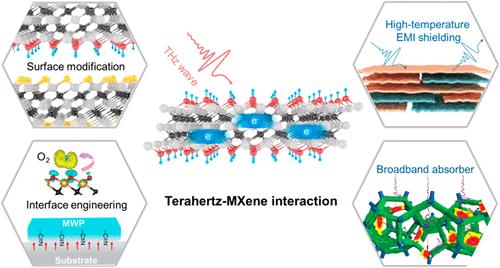太赫兹波与 MXene 的相互作用机理以及 MXene 用于太赫兹吸收和屏蔽的表面/界面化学。
摘要
Conspectus在过去的二十年里,太赫兹(THz)技术在各种科学和技术领域的进步和日益增长的太赫兹应用需求的推动下得到了快速发展。作为太赫兹技术的基石,强大的太赫兹-物质相互作用,特别是在纳米厚材料中实现的高太赫兹本征吸收,在包括但不限于太赫兹吸收/屏蔽、探测等各种应用中发挥着极其重要的作用。严谨的电磁理论认为薄膜对电磁波的最大本征吸收率为 50%,同时还提出了简洁的阻抗匹配条件来指导高本征吸收材料的设计。然而,当这些理论应用于带宽超宽的太赫兹频谱时,却面临着挑战。现有的薄膜通常只能在狭窄的频率范围内实现最大本征吸收,极大地限制了太赫兹吸收器和探测器的性能。在本开户绑定手机领体验金中,我们描述了具有纳米厚度的二维(2D)过渡金属碳化物和/或氮化物(MXene)薄膜如何实现超宽太赫兹波段的最大本征吸收,从而成功解决了上述长期存在的问题。令人惊讶的是,传统的直流阻抗匹配理论无法解释这一现象,而我们提出的交流阻抗匹配新理论却能给出令人满意的解释。通过深入研究自由电子在 MXene 中的微观传输行为,我们发现在太赫兹波激励下,片内传输主导着太赫兹传导性,而片间传输则主要决定着直流传导性。这不仅阐明了 MXene 中直流阻抗和交流阻抗之间的显著差异,还强调了交流阻抗匹配对于实现宽带太赫兹吸收极限的适用性。此外,我们还发现高电子浓度和短弛豫时间是在太赫兹机制下实现宽带最大吸收的关键因素。虽然 MXene 已接近太赫兹本征吸收极限,但在实际应用中仍面临障碍。首先,在合成过程中,MXene 表面存在多种不可控的端接,这在很大程度上影响了 MXene 的电子结构和太赫兹吸收特性。其次,MXene 在氧气和水的存在下稳定性较差。为了解决上述问题,我们开展了一些有特色的工作,通过表面和界面化学,如低温路易斯碱性卤化物处理和构建 Ti3C2Tx/萃取膨润土(EB)界面,精确控制 MXene 的端接并抑制其在高温下的氧化。出于实际应用的考虑,我们提出了一种基于共聚物-聚丙烯酸乳胶(PAL)的 MXene 水性涂料(MWP),PAL 中的氰基在 MWP 和基材之间产生了强烈的分子间极性相互作用。这不仅具有很强的太赫兹电磁干扰屏蔽/吸收效率,而且还能轻松附着在太赫兹频段常用的各种基底上。这些研究可能对 MXene 纳米薄膜在太赫兹光电器件中的未来应用具有重要意义。

ConspectusOver the past two decades, terahertz (THz) technology has undergone rapid development, driven by advancements and the growing demand for THz applications across various scientific and technological domains. As the cornerstone of THz technology, strong THz-matter interactions, especially realized as high THz intrinsic absorption in nanometer-thick materials, play a highly important role in various applications including but not limited to THz absorption/shielding, detection, etc. The rigorous electromagnetic theory has posited a maximum intrinsic absorption of 50% for electromagnetic waves by thin films, and the succinct impedance matching condition has also been formulated to guide the design of highly intrinsically absorbing materials. However, these theories face challenges when applied to the THz spectrum with an ultrabroad bandwidth. Existing thin films typically achieve a maximum intrinsic absorption within a narrow frequency range, significantly limiting the performance of THz absorbers and detectors. To date, both theoretical frameworks and experimental solutions are lacking in overcoming the challenge of achieving broadband maximum intrinsic absorption in the THz regime.In this Account, we describe how two-dimensional (2D) transition-metal carbide and/or nitride (MXene) films with nanometer thickness can realize the maximum intrinsic absorption in the ultrabroad THz band, which successfully addresses the forementioned longstanding issue. Surprisingly, traditional DC impedance matching theory fails to explain this phenomenon, while we instead propose a novel theory of AC impedance matching to provide a satisfactory explanation. By delving into the microscopic transport behavior of free electrons in MXene, we discover that intraflake transport dominates terahertz conductivity under THz wave excitation, while interflake transport primarily dictates DC conductivity. This not only elucidates the significant disparities between DC and AC impedance in MXenes but also underscores the suitability of AC impedance matching for achieving broadband THz absorption limits. Furthermore, we identify a high electron concentration and short relaxation time as crucial factors for achieving broadband maximum absorption in the THz regime. Although approaching the THz intrinsic absorbing limits, it still faces hurdles to the use of MXene in practical applications. First, diverse and uncontrollable terminations exist on the surface of MXene stemming from the synthesis process, which largely influence the electron structure and THz absorbing property of MXene. Second, MXene suffers from poor stability in the presence of oxygen and water. To address the above issues, we have undertaken distinctive works to precisely control the terminations and suppress the oxidation of MXene even at high temperature through surface and interface chemistry, such as low-temperature Lewis basic halide treatment and building a Ti3C2Tx/extracted bentonite (EB) interface. For practical application consideration, we proposed a copolymer-polyacrylic latex (PAL)-based MXene waterborne paint (MWP) with a strong intermolecular polar interaction between MWP and the substrate provided by the cyano group in PAL. This not only has strong THz EMI shielding/absorption efficiency but also can easily adhere to various substrates that are commonly used in the THz band. These studies may have significant implications for future applications of MXene nanofilms in THz optoelectronic devices.

 求助内容:
求助内容: 应助结果提醒方式:
应助结果提醒方式:


